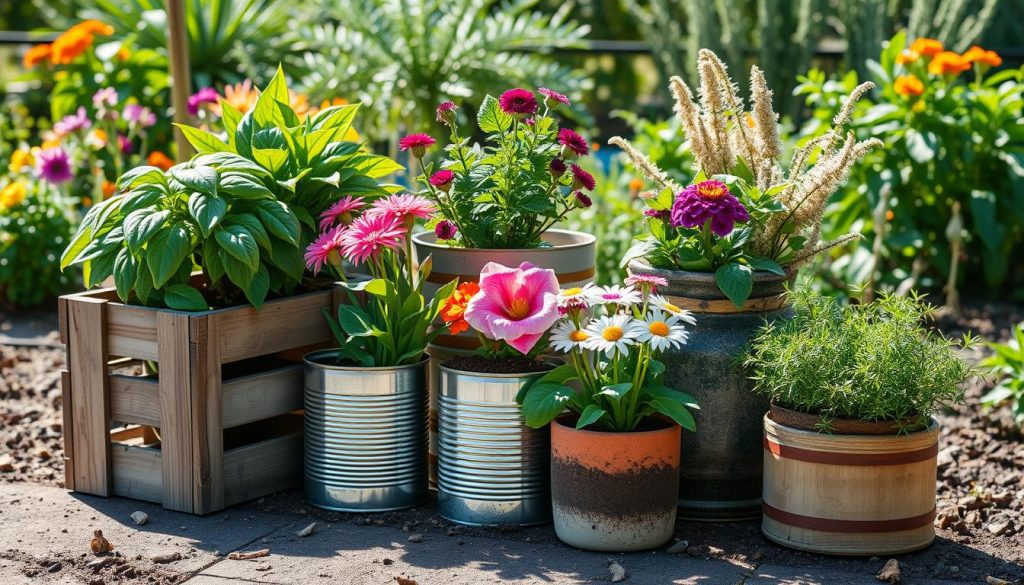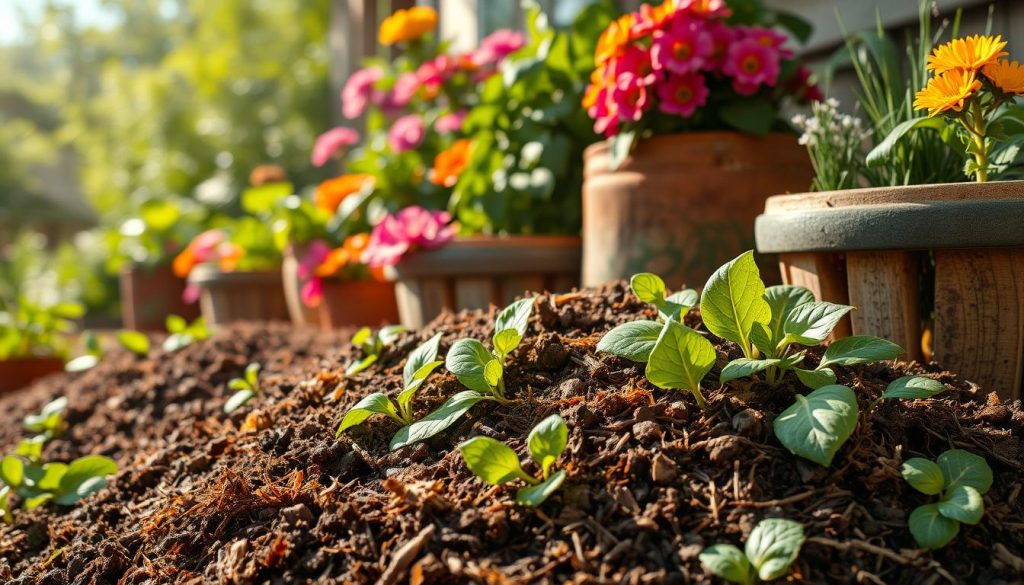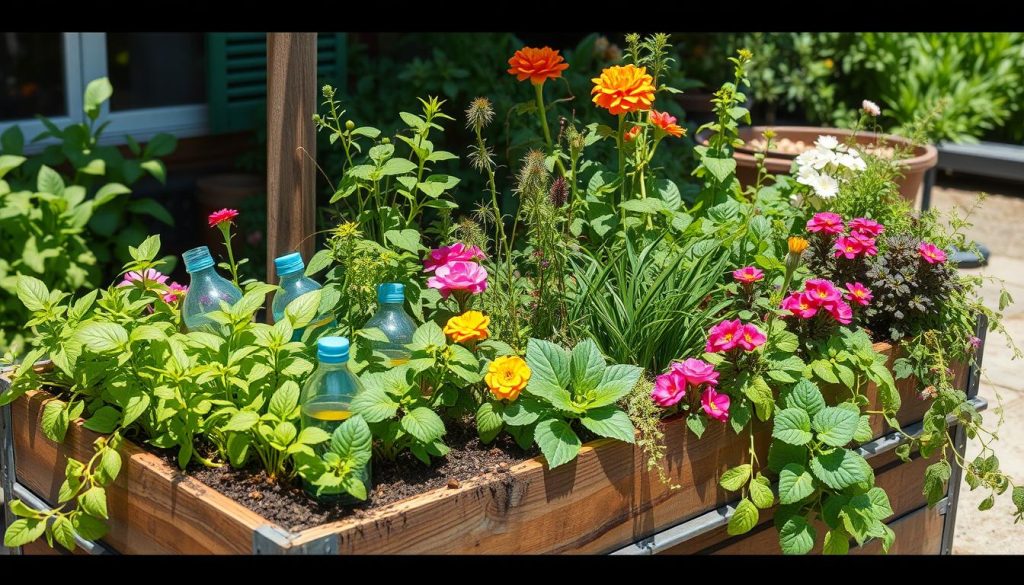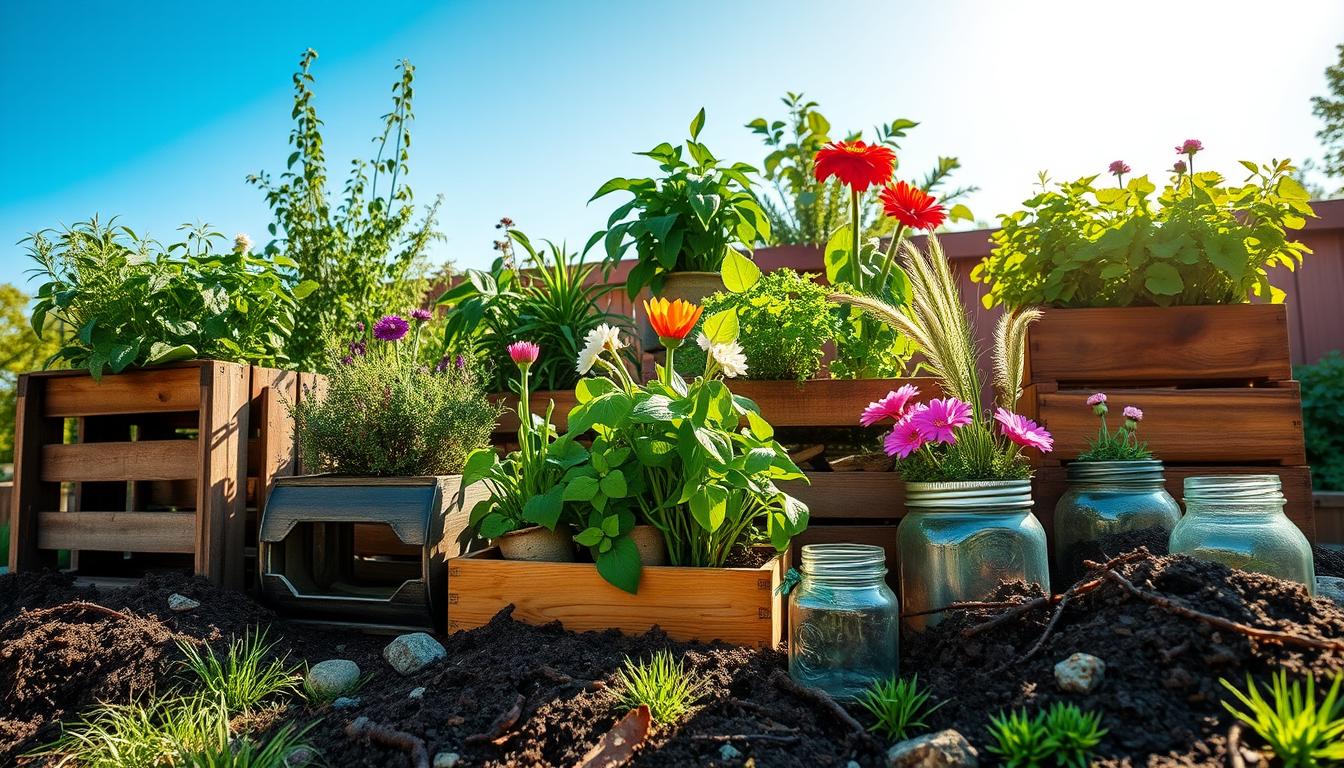I’m excited to share my zero-waste container gardening tips. They’ve helped me grow a beautiful garden while reducing waste. By using eco-friendly gardening tips, I’ve cut down on my environmental impact. In this article, I’ll guide you on how to start your own zero-waste garden.
Zero-waste container gardening offers many benefits, like reducing waste and growing your own food. I’ll talk about picking the right containers, making an eco-friendly potting mix, and choosing the best plants. My tips are for both new and experienced gardeners, aiming to help you grow a lush garden.
In this article, I’ll share my knowledge on sustainable gardening. This includes eco-friendly and zero-waste container gardening tips. By the end, you’ll know how to start your own zero-waste garden and enjoy its many benefits.
Understanding Zero-Waste Gardening Principles
Exploring zero-waste gardening has shown me how crucial it is to cut down on waste in our gardens. It’s not just about less trash; it’s about making our gardens sustainable and eco-friendly. By using green container gardening, we can lower our carbon footprint and help the planet.
Zero-waste gardening helps reduce landfill waste. By composting and reusing materials, we cut down on waste. This method also saves natural resources, lowers pollution, and supports a sustainable food system.
What Is Zero-Waste Gardening?
Zero-waste gardening aims to get rid of waste in every gardening step. It uses eco-friendly materials, saves water, and avoids harmful chemicals. This way, we make gardening more efficient and kind to the environment.
Benefits of Zero-Waste Practices
Zero-waste gardening offers many benefits. Some key advantages include:
- Less waste and pollution
- Conserving natural resources
- Better soil health and fertility
- Higher crop yields and healthier plants
Common Misconceptions I Encounter
Despite its many benefits, zero-waste gardening faces some myths. Many think it’s too time-consuming and expensive. But, with creativity and planning, a zero-waste garden can be both efficient and affordable.
Choosing the Right Containers for My Garden
Choosing the right containers is key for eco-friendly gardening. I look for reusable containers to cut down on waste. This choice is good for the planet and makes my garden special.
I like to use old pots, buckets, and wooden crates for my plants. These items can become unique planters with a bit of creativity. For example, an old wooden crate can hold herbs or succulents, adding a green touch to my garden.
Reusing Everyday Items
- Old pots and planters
- Wooden crates and boxes
- Plastic containers and buckets
I also think about the material of the containers and its effect on the environment. Terracotta, ceramic, and wood are great choices because they’re natural and can break down. These materials help reduce waste and support eco-friendly gardening.

Drainage and Airflow Considerations
Good drainage and airflow are vital for plants to thrive. I make sure my containers have enough holes for water to drain. This stops the soil from getting too wet and keeps roots healthy. I also make sure there’s enough air around my plants to prevent diseases and help them grow well.
Creating an Eco-Friendly Potting Mix
To practice sustainable gardening, making an eco-friendly potting mix is key. A good mix holds moisture, gives nutrients, and helps roots grow. This is crucial for zero-waste container gardening.
For green living container gardening, mix natural ingredients like compost, peat moss, and vermiculite. These can be found locally, cutting down on carbon emissions. This mix supports your plants’ health and meets your needs.
What I Include in My Mix
- Compost: rich in nutrients and microorganisms
- Peat moss: helps retain moisture and suppress weeds
- Vermiculite: improves drainage and aeration

Composting Kitchen Scraps for Nutrients
Composting kitchen scraps is a great way to cut down on waste. Adding food scraps, coffee grounds, and eggshells to your compost makes a natural fertilizer. This helps your plants grow strong.
Plant Selection for Zero-Waste Container Gardening
Choosing the right plants is key for a zero-waste container garden. I look at the plant’s native origin, growth habits, and how it gets along with others. This way, I can make a garden that’s both beautiful and eco-friendly.
Native plants are a great choice for gardening. They’re tough because they’re used to the local weather and soil. Herbs like basil and mint, and flowers like petunias and marigolds, are good examples. Using organic gardening methods helps my garden grow strong and helps the planet too.
Native Plants vs. Non-Native Plants
Native plants need less water and care, which is good for the planet. Non-native plants might need more help, which can harm the environment. Choosing native plants makes my garden more sustainable.
Companion Planting Strategies
Companion planting pairs plants for mutual benefit. For instance, marigolds keep nematodes away from tomatoes. Basil and mint taste better together. This way, my garden is diverse and needs less care.

Edible Plants that Thrive in Containers
Many edible plants grow well in containers. Leafy greens, herbs, and even tomatoes can thrive. Using eco-friendly gardening tips, I can grow food and reduce waste. Here are some examples:
- Tomatoes
- Peppers
- Cucumbers
- Carrots
- Radishes
By picking the right plants and using smart gardening strategies, I can have a zero-waste garden. It’s good for me and the planet. Always choose plants that do well in containers and are easy to care for. Try different planting combinations to see what works best for your garden.
Maintenance Tips for a Thriving Garden
To keep my eco-friendly container garden healthy, I use smart water-saving methods. I mulch around the plants to keep moisture in and use drip irrigation to water the roots directly. I also collect rainwater in barrels to cut down on water use.
For pest control, I rely on natural solutions. I introduce beneficial insects and make organic repellents from herbs and essential oils. Regular checks on my plants help me catch and fix any problems early.
Throughout the year, I stick to a seasonal care plan. In spring, I update the potting mix and trim back any plants that got too big over winter. Summer is all about watering right and watching for heat stress. As fall comes, I mulch and protect my plants from the cold.
These sustainable gardening tips help me keep my zero-waste garden thriving. It’s rewarding to see my garden grow and know I’m helping the planet. With a bit of effort, anyone can enjoy the joys of eco-friendly container gardening.
section>

